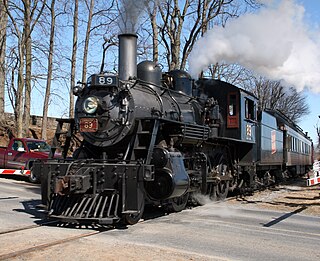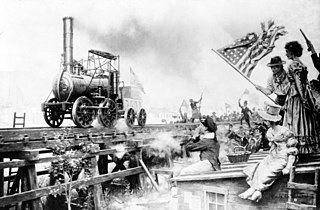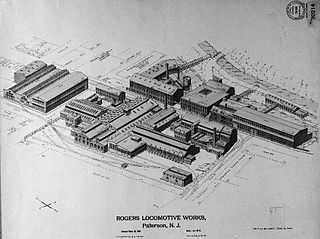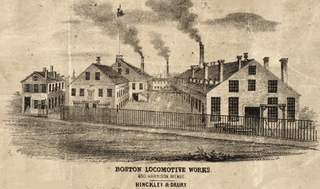Related Research Articles

The history of rail transport began in the prehistoric times. It can be divided into several discrete periods defined by the principal means of track material and motive power used.

4-4-0 is a locomotive type with a classification that uses the Whyte notation for the classification of steam locomotives by wheel arrangement and represents the arrangement: four leading wheels on two axles, four powered and coupled driving wheels on two axles, and a lack of trailing wheels. Due to the large number of the type that were produced and used in the United States, the 4-4-0 is most commonly known as the American type, but the type subsequently also became popular in the United Kingdom, where large numbers were produced.

Under the Whyte notation for the classification of steam locomotives, 2-6-0 represents the wheel arrangement of two leading wheels on one axle, usually in a leading truck, six powered and coupled driving wheels on three axles and no trailing wheels. This arrangement is commonly called a Mogul.

The Stourbridge Lion was a railroad steam locomotive. It was the first to be operated in the United States, and one of the first locomotives to operate outside Britain. It takes its name from the lion's face painted on the front, and Stourbridge in England, where it was manufactured by the firm Foster, Rastrick and Company in 1829. The locomotive, obtained by the Delaware & Hudson Canal Company, was shipped to New York in May 1829, where it was tested raised on blocks. It was then taken to Honesdale, Pennsylvania for testing on the company's newly built track. The locomotive performed well in its first test in August 1829 but was found to be too heavy for the track and was never used for its intended purpose of hauling coal wagons. During the next few decades a number of parts were removed from the abandoned locomotive until only the boiler and a few other components remained. These were acquired by the Smithsonian Institution in 1890 and are currently on display at the B&O Railroad Museum in Baltimore.

Rogers Locomotive and Machine Works was a 19th-century manufacturer of railroad steam locomotives based in Paterson, in Passaic County, New Jersey, in the United States. It built more than six thousand steam locomotives for railroads around the world. Most 19th-century U.S. railroads owned at least one Rogers-built locomotive. The company's most famous product was a locomotive named The General, built in December 1855, which was one of the principals of the Great Locomotive Chase of the American Civil War.

Hinkley Locomotive Works was a steam locomotive manufacturer based in Boston, Massachusetts in the 19th century.

Tom Thumb was the first American-built steam locomotive to operate on a common-carrier railroad. It was designed and constructed by Peter Cooper in 1829 to convince owners of the newly formed Baltimore and Ohio Railroad (B&O) to use steam engines; it was not intended to enter revenue service. It is especially remembered as a participant in a perhaps mythical race with a horse-drawn car, which the horse won after Tom Thumb suffered a mechanical failure. However, the demonstration was successful, and the railroad committed to the use of steam locomotion and held trials in the following year for a working engine.
This article lists events relating to rail transport that occurred during the 1790s.
This article lists events relating to rail transport that occurred during the 1780s.
References
- ↑ Guy, Andy; Rees, Jim (2011). Early Railways, 1569–1830. Oxford: Shire Books. p. 44. ISBN 978-0-7478-0811-4.
- ↑ Marshall, John (2003). Biographical dictionary of Railway Engineers. Oxford: Railway & Canal Historical Society. ISBN 0-901461-22-9.
- White, John H. Jr. (1968). A history of the American locomotive; its development: 1830–1880. New York, NY: Dover Publications. ISBN 0-486-23818-0.
- White, John H., Jr. (Spring 1986), America's Most Noteworthy Railroaders, Railroad History, 154, p. 9–15.